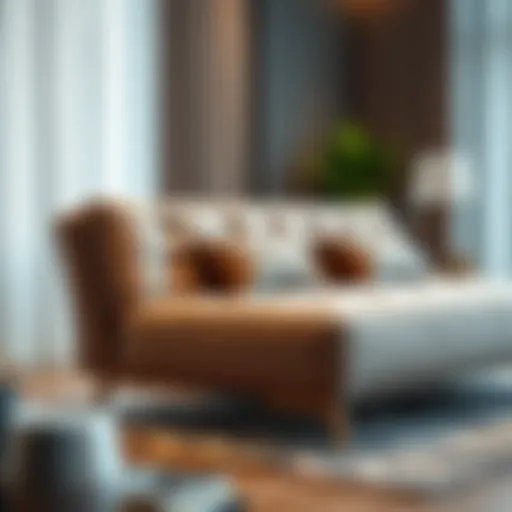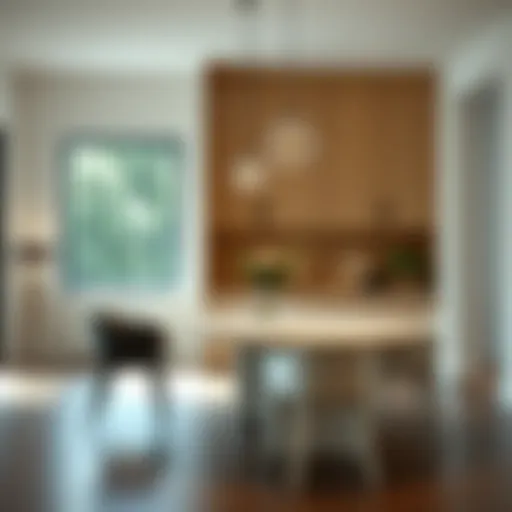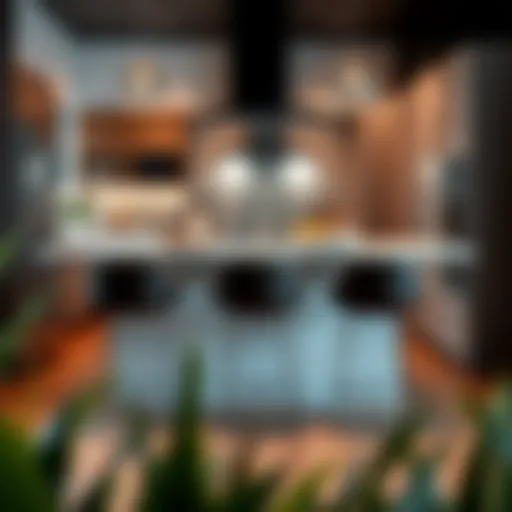Maximizing Kitchen Organization with Cutting Board Cupboards


Intro
In today’s bustling kitchen environment, organization plays a pivotal role in streamlining meal preparation. One often overlooked element is the cutting board cupboard, which serves not only as a storage solution but also as a design feature that speaks to the overall aesthetic of the space. This article examines how cutting board cupboards contribute to kitchen efficiency while enhancing visual harmony. We’ll explore the latest design trends, practical solutions, materials, and how these cupboards can be seamlessly integrated into various kitchen layouts.
Design Trends
As kitchens evolve into multifunctional spaces, the significance of integrating cutting board cupboards within their design is essential. These cupboards are not just about storage; they represent a confluence of style and utility. Using the right design elements can transform a basic cupboard into a statement piece.
Contemporary Styles
Modern kitchens lean towards sleek, minimalistic designs that prioritize functionality without compromising aesthetics. The cutting board cupboard has embraced this shift, showcased by designs that feature clean lines and unobtrusive hardware. For instance, consider cabinets that blend in with surrounding cabinetry, creating a cohesive look that doesn’t draw attention away from other design elements.
Additionally, many contemporary styles opt for open shelving, allowing easy access to cutting boards while contributing to an airy feel in the kitchen. This trend emphasizes both accessibility and style, making it a popular choice among homeowners.
Color Palettes and Materials
When it comes to materials, the choices are vast. From natural woods to engineered composites, the right material can significantly impact the visual appeal of the kitchen. While rich wood tones add warmth, high-gloss finishes can impart a modern flair. For instance, bamboo cutting board cupboards not only bring an eco-friendly touch but also a unique texture that can be quite appealing in contemporary spaces.
The color palette plays an equally critical role. Shades like soft whites and earth tones create a calming atmosphere, while bold colors can add a burst of energy. Mixing materials, such as incorporating stainless steel alongside wood, can provide an interesting contrast and cater to a variety of design preferences.
"The cutting board cupboard is where function meets form in the modern kitchen, offering a unique opportunity for personalization."
Functional Solutions
While style is important, functionality cannot be disregarded in kitchen organization. The cutting board cupboard should be equipped to enhance usability while ensuring that the cooking space remains tidy and accessible.
Ergonomic Furniture
Ergonomics plays a significant role in kitchen design. Cutting board cupboards should be placed at a height conducive to comfort, minimizing strain during food prep. For example, pull-out shelves can be an excellent addition, allowing easy access to cutting boards without bending or scrambling to reach them. Features like these not only cater to comfort but also maximize efficiency during cooking.
Space Optimization Tips
Moreover, optimizing space is crucial, primarily in kitchens where every inch counts. Integrating vertical storage solutions—like cabinets that go up to the ceiling—can free up counter space while providing ample room for cutting boards and other accessories. Similarly, consider the inclusion of dividers within the cupboard. This allows for organized storage of various cutting boards, ensuring that the often chaotic atmosphere of cooking is kept at bay.
Preamble to Cutting Board Cupboards
In today's culinary landscape, cutting board cupboards are often overlooked yet they play a crucial role in both functionality and aesthetic charm of the kitchen. These specialized storage solutions cater to the often-chaotic nature of cooking spaces, providing a dedicated area for cutting boards, and by extension, cooking essentials. When organized properly, they can transform a cluttered kitchen into a sanctuary of creativity and efficiency.
Focusing on the importance of cutting board cupboards goes beyond mere storage; it touches upon optimizing workflow, enhancing organization, and significantly impacting the flow of daily cooking tasks. A thoughtfully designed cutting board cupboard seamlessly integrates into the overall kitchen layout, maintaining a balance between accessibility and tidiness. For architects and interior designers, recognizing the potential of these cupboards allows for greater harmony in kitchen design, as form meets function in this underappreciated spatial element.
"A well-organized kitchen is not just a luxury; it’s an investment in the culinary experience."
Importance in Kitchen Design
Cutting board cupboards are more than just functional; they are integral to kitchen design. Placing these cupboards strategically can help in the efficiency of food preparation, making it easier for chefs—both amateur and professional—to keep their workspaces clutter-free. The visibility of cutting boards becomes simplified. When they’re tucked away neatly, they invite a breath of calm into bustling kitchen activities.
Moreover, they can influence the overall aesthetic of a kitchen. By choosing the right materials and finishes, a cutting board cupboard can complement or contrast with surrounding cabinetry, enhancing visual interest. From biophilic designs that incorporate natural wood finishes to modern, minimalist looks featuring sleek metals, these cupboards help in expressing the unique personality of the kitchen.
Evolving Styles and Trends
The design of cutting board cupboards is continually evolving, reflecting broader kitchen trends. With the rise of open-concept living, homeowners are looking for ways to maintain a sense of order while ensuring their kitchens remain inviting and warm. Traditional solid wood cupboards are being paired with glass fronts to create a sense of openness, balancing style with visibility.
Furthermore, technological advancements have introduced innovative solutions. Integrated cutting board cupboards now often include features like built-in knife blocks or even small pull-out prep surfaces. As consumers become more environmentally conscious, the trend is shifting towards sustainable materials, such as reclaimed woods or bamboo, which offer the same durability but with a lower environmental impact.
Adapting to these trends is essential for retailers and designers alike. Showcasing a collection that blends functionality with contemporary style can appeal to an expanding market that values both utility and aesthetics.
Functional Aspects of Cutting Board Cupboards


When it comes to kitchen organization, cutting board cupboards play a vital role. Their functional aspects not only improve storage solutions but also contribute significantly to the efficiency of meal preparation. These cupboards are designed to accommodate a variety of needs, and understanding their capabilities can lead to a more streamlined kitchen experience.
Maximizing Space Efficiency
In many kitchens, space is a precious commodity. Cutting board cupboards are ingeniously designed to make the most of the available area. By incorporating vertical storage solutions, these cupboards allow for the stacking of cutting boards without sacrificing accessibility. For example, installing pull-out shelves or compartments specifically for cutting boards means you don’t have to rummage through multiple cabinets to find the one you want.
Moreover, the clever arrangement of space allows for better housing of other culinary tools and related items. Think about it; often, a chef’s knife, a peeler, and several cutting boards reside in different spots. A cutting board cupboard keeps these items together, enabling cooks to grab everything they need in one go, saving precious time during the cooking process.
"The more organized your kitchen, the smoother your culinary journey will be."
To illustrate this idea, consider a typical scenario: a wall-mounted cutting board cupboard with side slots can easily accommodate several boards while providing a few drawers for knives and utensils. This way, every item has its place, freeing up counter space and creating an open area for food prep.
Here's a quick list of space-maximizing features you might find:
- Pull-out shelves for easy access
- Vertical slots for board storage
- Drawer organizers for utensils
- Customizable compartments to fit various board sizes
Integration with Kitchen Workflow
Cutting board cupboards are not just about storage; their design is often centered around a seamless cooking workflow. A well-thought-out kitchen setup enhances efficiency, and cutting board cupboards can be tailored to ensure they align with this goal. For instance, having a cutting board cupboard placed near the prep sink or stove allows cooks to transition smoothly from washing to chopping to cooking without unnecessary movement.
The placement can make all the difference. If you frequently find yourself making a mess from traversing across a cluttered kitchen to grab your cutting board, it may be time to rethink the layout. A cupboard that facilitates easy access promotes a more functional space. You also have to consider the dimensions; the height and reach need to be comfortable to prevent strain while working.
In addition to the placement, the design can accommodate multi-tasking. Some cupboards feature built-in knife holders or cooking gadgets, which perfectly complement cutting boards. The more a cutting board cupboard can do without taking up extra space, the better it serves your kitchen workflow.
Finale on Functionality
Ultimately, the functional aspects of cutting board cupboards cannot be overstated. From maximizing space efficiency to improving how efficiently a kitchen operates, these cupboards serve as integral players in modern kitchen organization. When properly utilized, they can transform an everyday kitchen into an organized, efficient workspace that enhances both creativity and functionality.
Materials Used in Cutting Board Cupboards
Selecting the right materials for cutting board cupboards is pivotal, serving not only practical functions but also contributing to the overall aesthetic of the kitchen. Choosing the right component can affect durability, maintenance need, and even the harmony of design within a culinary space. For those practioners—like interior designers and architects—looking to refine their projects, understanding materials is integral.
In kitchens where cleanliness and efficiency are paramount, the choice of material can streamline organization while enhancing visual appeal. It's integral to assess factors such as water resistance, ease of cleaning, and compatibility with kitchen tools. For example, a cutting board cupboard made from certain woods can be more susceptible to warping from moisture, while alternatives like metals offer unparalleled longevity.
Next, we'll delve into the specific materials commonly used in crafting these essential kitchen features.
Common Wood Choices
When it comes to wood options for cutting board cupboards, the classic choices tend to shine due to their aesthetic and functional qualities.
- Maple: Known for its durability and fine grain, maple is often a first pick. It's tough enough to withstand daily use, making it a long-term investment. Plus, it has a warm tone that can effortlessly blend with various kitchen styles.
- Bamboo: This eco-friendlt alternative has gained popularity for both sustainability and functionality. It’s naturally antimicrobial, which is a boon in kitchens. Also, it gives a contemporary edge with its light, trendy appearance.
- Walnut: Provides a rich, dark hue that adds sophistication to any cabinet. It can be a tad pricey, but its beauty and durability often justify the investment.
These wood choices each have characteristics that could supplement or detract from a design. It's crucial that designers think not just about the look but the practicalities—how often will it need to be replaced?
"Choosing the right materials can elevate not just the functionality of a cutting board cupboard but also its style, creating a cohesive kitchen aesthetic."
Durable Alternatives
Not to disregard the solid performance of wood, several durable alternatives present their own unique advantages.
- Stainless Steel: Highly resistant to moisture, heat, and impact, steel is often found in commercial kitchens but is making its way into residential designs. It's easy to clean, making it ideal for high-use spaces.
- High-Density Polyethylene (HDPE): Commonly used for cutting boards, HDPE is non-porous and won't harbor bacteria. It’s resistant to warping from temperature changes, making it an excellent choice for cupboards as well.
- Glass: A sophisticated choice, tempered glass not only offers a modern look but also has the added benefit of being non-absorbent. Glass can be a striking feature but requires careful handling as it can be prone to chipping.
When weighing alternatives, consider the kitchen's overall style and expected use to ensure a good fit. Each material has its perks and pitfalls, making it vital to align choices with the homeowner's lifestyle and design vision.
Design Variations in Cutting Board Cupboards
Design variations in cutting board cupboards play a crucial role in both functionality and aesthetics within the kitchen. These cupboards are not just about storage; they influence the overall flow and usability of the kitchen space. A well-chosen design can significantly enhance your culinary experience while providing a tailored solution to meet unique organizational needs.
When exploring the different styles available, considerations such as available space, kitchen layout, and personal taste come into play. The way these cupboards are integrated can affect everything from how easily you access your cutting boards to how well they complement the existing décor of the kitchen. Let's take a closer look at three prevalent design variations: wall-mounted options, under-counter designs, and freestanding models.


Wall-Mounted Options
Wall-mounted cutting board cupboards have become increasingly popular for kitchens that are short on space. These designs capitalize on vertical storage, providing an efficient way to keep cutting boards accessible yet out of the way. One of the prominent benefits of this type is that it allows for easy visualization of all the tools you might need while cooking. You can simply reach up to grab a board without needing to bend down or sift through cabinets.
When installing wall-mounted options, you should consider the height and reach. Proper installation at a comfortable level can make all the difference. Plus, there's potential for added flair. Many come with customizable finishes or even open shelving to showcase attractive boards, letting them blend with your kitchen aesthetics. Think of it as a canvas where your cutting boards can act as art pieces.
Under-counter Designs
Under-counter cutting board cupboards are a classic solution, fitting seamlessly within your kitchen cabinetry. These designs typically provide a more discreet storage solution while still ensuring easy access during meal preparation. One of the upsides here is that it can help in maintaining a clean countertop, as the boards are neatly tucked away until needed.
In terms of practicality, this design can often incorporate drawers or pull-out shelves, allowing for the easy organization of different sizes and types of cutting boards. Think about it: having everything tucked away yet ready to go saves both time and effort. When selecting under-counter designs, careful measurement is key. You want to ensure that there's adequate room between the shelves, allowing for ventilation and accessibility without causing wear and tear on your cutting boards.
Freestanding Models
Freestanding cutting board cupboards are a beacon of versatility in the kitchen. Offering flexibility in terms of placement, they can be relocated according to needs or seasonal dining arrangements. These models often come equipped with additional storage features such as drawers, shelves, and sometimes even wheels for mobility. A major benefit of this type is that it allows for easy incorporation of smaller appliances, making them a multi-functional asset in your kitchen setup.
Moreover, freestanding cupboards can serve as a stylistic centerpiece, as they come in various designs that can stand out or blend in with your kitchen theme. It’s a valuable addition if you anticipate needing a dedicated prep area that can flexibly adapt to your cooking style or entertaining needs.
"Deciding on the right design variation can greatly enhance not only the utility but also the charm of your kitchen space."
Maintenance of Cutting Board Cupboards
The significance of maintenance for cutting board cupboards cannot be overstated. These essential kitchen elements serve not just as storage spaces, but as crucial components that influence the overall functionality and longevity of your kitchen environment. With regular upkeep, you can ensure they remain in excellent condition while enhancing the overall aesthetics and efficiency of your kitchen space. The benefits of proper maintenance are manifold, ranging from increasing the lifespan of the cupboards to promoting a hygienic cooking atmosphere. By establishing a solid cleaning routine, you ensure that this piece of furniture continues to serve its purpose effectively and retains its visual appeal.
Regular Cleaning Practices
Regular cleaning is your first line of defense against wear and tear, deterioration, and unwanted odors. With a few simple steps, you can easily maintain your cutting board cupboards in pristine condition.
- Daily Wipe Down: After each use, it’s vital to quickly wipe down the surfaces with a damp cloth to remove crumbs or spills. This simple habit can prevent grime build-up.
- Use Mild Detergents: It’s advisable to use mild soap and warm water for deeper cleans rather than harsh chemicals that might damage the wood or finish. A gentle scrub with a soft sponge should do the trick.
- Oil the Wood: Depending on the materials used, applying mineral oil or a wood conditioner every couple of months can help preserve the wood’s integrity and keep it looking fresh. This adds a layer of protection, ensuring moisture doesn’t seep in, which can lead to warping or cracking.
"Regular maintenance might feel like a small task, but it pays off immensely in the long run by prolonging the lifespan of your cupboards and maintaining your kitchen’s overall charm."
- Avoid Leaving Standing Water: Make sure not to allow any water to accumulate on the surface. It might seem harmless, but over time, it can contribute to mold or mildew growth.
By incorporating these straightforward cleaning practices into your routine, you position your cutting board cupboards for a long, fulfilling life in your kitchen.
Seasonal Inspections
While daily cleaning routines set the groundwork, seasonal inspections take this a step further. These inspections play a crucial role in safeguarding your investment through early detection of potential issues.
- Visual Checks: Every season, take the time to inspect the cupboards for signs of damage, such as scratches, dents, or loose hinges. Addressing these promptly prevents more extensive problems later on.
- Check for Levelness: Over time, few things can cause cabinets to shift or become misaligned. Use a level to check if your cupboard is still straight. If it's leaning, it may need adjustments or reinforcements.
- Look Beneath the Surface: Pay attention to areas like the corners and the underside. Sometimes dirt or food particles can accumulate, creating a breeding ground for pests. Ensure these hidden spaces are clean and free from clutters.
- Check the Finish: Depending on the type of wood finish, you might need to reapply protective coating once or twice a year. This not only enhances appearance but also fortifies against spills and stains.
By incorporating regular maintenance and seasonal inspections into your kitchen care routine, you’ll be taking substantial strides toward ensuring that cutting board cupboards not only serve their purpose efficiently but also contribute to the overall kitchen organization and visual appeal.
Aesthetic Considerations
In the realm of kitchen design, aesthetic considerations are paramount. Cutting board cupboards, while primarily functional, also serve as a focal point within the space. They contribute to the overall ambiance, merging practicality with visual delight. Choosing the right aesthetic elements can elevate not just the cupboards themselves but the kitchen environment as a whole. When designing or selecting cutting board cupboards, it is essential to keep a few key elements in mind.
Color Schemes and Finishes
The color scheme plays a crucial role in how cutting board cupboards integrate into the kitchen. A well-chosen color palette can enhance the flow of the space and invite harmony among various kitchen elements.
- Neutral Tones: Shades like beige, white, or gray provide a clean and modern look. They can make the kitchen feel larger while also allowing brighter accent colors in other elements.
- Bold Colors: Shaded in deep blues, reds, or greens can make a striking statement. This approach works well in eclectic or farmhouse-style kitchens where personality is key.
- Natural Wood Finishes: Using raw or lightly stained wood not only brings warmth but also connects the space to earthy vibes. It's particularly appealing for those looking to create a rustic or organic feel.
Choosing the right finish is equally important. High-gloss finishes might offer a contemporary flair, while matte finishes can add a touch of softness. Texture can also play a role; smooth finishes present a sleek look, whereas a rough-hewn style brings a casual, hands-on feel.
Harmonizing with Kitchen écor
For cutting board cupboards to shine, they must harmonize with existing kitchen décor. This means more than simply matching colors; it involves considering style coherence and contextual relevance.


- Complementing Cabinetry: The chosen style of the cutting board cupboard should ideally echo the cabinetry and furniture in the kitchen. If the cabinets are shaker style, cutting board cupboards with similar design details will create visual continuity.
- Coordinating with Countertops: Countertops often serve as the centerpiece of a kitchen. Whether opting for a butcher block or quartz, the cupboards should enhance or contrast beautifully without clashing.
- Accents and Accessories: Small details matter. If you have decorative knobs, handles, or integrated lighting, these elements can either complement or clash with the cupboards. Thinking about every small piece as part of the larger aesthetic can help achieve a cohesive look.
As outlined, aesthetic considerations are far from superficial. They shape how a kitchen feels and functions. Ignoring the interplay of colors, materials, and design nuances could mean missing out on a truly cohesive and inviting space.
The Role of Customization
In the realm of kitchen organization, customization plays a pivotal role, particularly when it comes to cutting board cupboards. Tailoring solutions to specific needs not only enhances functionality but also aligns with the unique persona of a kitchen space. A well-designed cupboard can effectively eliminate clutter and chaos, making meal prep a breeze. The primary elements of customization — size, style, and functionality — allow homeowners to harmonize their cutting board cupboards with their kitchen's overall layout and design theme.
Customization enables users to consider their available space, the dimensions of cutting boards they frequently use, and the materials that suit their kitchens best. For instance, a small galley kitchen would benefit from a vertically oriented cupboard to save on horizontal space, while a more expansive kitchen can accommodate larger, countertop-style cupboards. Additionally, the option to select finishes and colors means that the cupboard can blend seamlessly with existing cabinetry and décor, thereby enhancing the visual appeal of the kitchen.
Tailoring for Specific Needs
When it comes to tailoring cutting board cupboards for specific needs, the first step is to assess the kitchen's layout and the culinary habits of its users. For example, someone who cooks daily may require a larger, more accessible setup than someone who primarily uses their kitchen for light meal preparations.
- Size and Accessibility: A cabinet that allows for easy access to frequently used items can make a world of difference. Pull-out shelves or sliding compartments might be perfect for users dealing with limited mobility.
- Material Preferences: Customization also allows for the selection of materials that withstand the test of time and regular use. Those who favor eco-friendly products may opt for bamboo or reclaimed wood. Meanwhile, those who prioritize aesthetics might choose a glossy finish or a striking natural grain.
- Incorporating Additional Features: For the culinary enthusiast, incorporating features like built-in knife holders or integrated spice racks can further maximize utility. These little personal touches can drastically enhance the overall kitchen experience, making it more tailored to individual cooking styles.
Working with Designers
Partnering with designers when creating customized cutting board cupboards offers significant advantages. These professionals bring an understanding of spatial dynamics that can help homeowners see possibilities they might overlook. Experienced designers not only consider aesthetic values but ensure that every element remains functional and practical.
- Collaboration: A personalized consultation allows clients to articulate their specific needs and preferences. Designers can suggest innovative solutions based on their expertise.
- Balancing Style and Functionality: Designers can balance the need for beautiful aesthetics with functional aspects, ensuring that the final product is both eye-catching and applicable.
- Quality and Durability: Professional designers often have established relationships with suppliers to source high-quality materials that resist wear and tear over time. They help ensure that the final product is a blend of artistry and practicality.
Custom kitchens are not just spaces to cook; they are reflections of personal style and functionality. A well-planned and customized cutting board cupboard is an integral part of that vision.
In summary, customization transforms a cutting board cupboard from a mere storage solution to an essential piece of a kitchen's personality. The process of tailoring cupboards to meet specific needs, coupled with expert designer collaboration, can usher in a new level of organization and elegance to kitchen spaces.
The Future of Cutting Board Cupboards
As we navigate through the shifting landscape of modern kitchen design, cutting board cupboards continue to find their place at the intersection of functionality and aesthetic appeal. The future of cutting board cupboards is not just about storing cutting boards; it's about enhancing the overall kitchen experience. This section aims to explore innovative designs and sustainable practices shaping this evolution, offering insights essential for interior designers, architects, and retailers.
Innovative Designs
The concept of cutting board cupboards is experiencing a renaissance. Designers are pushing the envelope by integrating multifunctional elements while maintaining a sleek appearance. For instance, picture a cutting board cupboard that seamlessly slides into cabinetry, emerging only when needed. This design not only saves space but also adds an element of surprise to kitchen functionality.
Consider also the rise of modular units, allowing homeowners to customize their removible cutting boards and cupboard spaces depending on their cooking habits. Some leading brands have adopted a two-tone wood design that aligns with minimalistic aesthetics while offering durability. These innovative takes prioritize both user experience and kitchen flow, making it easier to access tools with minimal disruption.
"The kitchen of the future won’t just be about cooking; it will be a personal expression that merges utility with style."
Moreover, technology is becoming a player in this arena with smart cupboards equipped with sensors. Solutions are emerging that provide notifications when it’s time to sharpen those beloved wooden boards or maybe even reminders to clean them according to the calendar. Not only does this enhance the quality of kitchen tools, but it also ties into the overall maintenance of culinary excellence.
Sustainable Practices
With the greater emphasis on sustainability in every aspect of life today, cutting board cupboards are no exception. The future involves materials and designs that minimize environmental impact while delivering high performance. More manufacturers are turning to reclaimed wood, ensuring each cutting board cupboard tells a story and reduces waste. These practices resonate with eco-conscious consumers who prefer individual history behind their culinary tools.
Another noteworthy trend is sourcing materials from sustainable forests, thereby ensuring that the wood used in cupboards is harvested responsibly. This practice speaks volumes about a brand’s commitment to responsible crafting and longevity in the industry. Furthermore, finishes made from natural oils or low-VOC products contribute to a healthier indoor environment, beneficial for the home cooks who spend hours in the kitchen.
A growing number of companies are exploring biodegradable materials as well. As consumers become more aware of waste, the potential for eco-friendly designs using composite materials holds promise. This shift signifies a larger movement towards circular economy models, where cupboard designs become an essential part of sustainable living.
In summation, the future of cutting board cupboards is ripe with possibilities. From innovative designs enhancing efficiency to sustainable practices defining choices for materials, there's a wave of transformation underway. By being aware of these changes, designers, architects, and retailers can play an essential role in fostering kitchen environments that are both functional and conscientious.
The End
Cutting board cupboards play a pivotal role in kitchen organization, transcending mere utility to become a fundamental aspect of modern design. These specialized storage solutions not only keep cutting boards neatly out of sight but also enhance the overall workflow of the kitchen. By incorporating such cupboards, kitchen designers and homeowners can strike a fine balance between function and style, ensuring that every piece contributes to the harmonious environment of culinary creation.
Summarizing the Essential Role
When we think of a kitchen, we often picture the vibrant activity that takes place within its confines. Cutting board cupboards emerge as silent workhorses during this bustling scenario. Their essential role is to provide a dedicated space for cutting boards, which can often clutter countertops if left unorganized. Having a specific location encourages their proper use and can increase the speed of meal preparation.
Furthermore, the design of these cupboards can vary widely, addressing different needs and aesthetically complementing the rest of the kitchen elements. Be it a sleek, wall-mounted option that saves valuable counter space or an under-counter design that integrates smoothly into cabinetry, each style serves a unique purpose. By ensuring that cutting boards are readily accessible, kitchens can operate more efficiently, showcasing the seamless interplay between design and functionality.
Encouragement for Thoughtful Design Choices
As one navigates the journey of kitchen design, it becomes increasingly clear that thoughtful choices yield superior results. When selecting a cutting board cupboard, consider not only its practicality but also its integration with the overall kitchen layout.
- Material Selection: Choosing the right wood or durable alternatives can enhance longevity and elevate the aesthetic. Popular choices might include maple or bamboo, both known for their durability and beauty.
- Style Considerations: Assess whether a modern, minimalist look or a rustic, farmhouse style fits better with the desired kitchen theme. Each design holds unique charm, and selecting one that resonates can strengthen the space’s identity.
- Functionality Over Aesthetics: While appearance is important, ensure that the chosen cupboard fulfills the functional requirements of the household. Customizations, like adjustable shelving, can assist in better space management.















